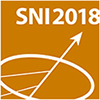$Cs_2CuCl_4$ and $Cs_2CuBr_4$ are anisotropic triangular lattice materials, where $Cu^{2+}$ ions with S=1/2 form frustrated 2D planes [1,2]. The mixed system $Cs_2CuCl_{4-x}Br_x$ is used to study the effect of controlled-quenched disorder in the spin superstructure lattice. Preferential occupation of Cl/Br leads to selective disorder in the lattice and some well-ordered structures. The neutron...
Small-angle neutron scattering (SANS) is a powerful method to resolve the magnetic microstructure in the bulk and on length scales between about 1 − 100 nm. We have used this technique to study Fe-based two-phase nanocrystalline alloys. In the investigated soft magnetic heterogeneous nanocomposites, the jump of the magnetization at the phase boundary between particles and matrix gives rise to...
The exchange bias effect refers to the unidirectional shift of the hysteresis loop of a magnetization curve, conventionally that of a ferromagnet in direct contact to an antiferromagnet. Chiral magnetism, on the other hand, that manifests in the existence of skyrmions or chiral domain walls, offers an alternative way for creating anisotropies in magnetic materials that might have large...
Understanding the physical properties of systems which are simultaneously subject to strong spin-orbit coupling (SOC) and electron correlations is an en vogue research area and triggered intensive studies e.g. by neutron and x-ray spectroscopy methods. These studies revealed novel electronic and magnetic phases in 4d and 5d materials. At one level, SOC introduces another competing energy...
Heavy metal/ferromagnetic insulator (HM/FMI) heterostructures provide a unique platform for the generation and detection of pure spin currents in the fields of spintronics and spin caloritronics. In these HM/FMI heterostructures, the transport of the spin current across the HM/FMI interface is of key importance. Thereby the quality of the interface highly affects the interfacial interaction...
Besides the well-known vortex lattice (VL), type-II/1 superconductors exhibit the intermediate mixed state (IMS), where VL domains and Meissner domains coexist, due to an attractive component of the VL interaction [1]. Despite some work in the 1970s, no detailed theoretical model for the IMS exists. Primary obstacles are the inapplicability of most standard models of superconductivity and the...

